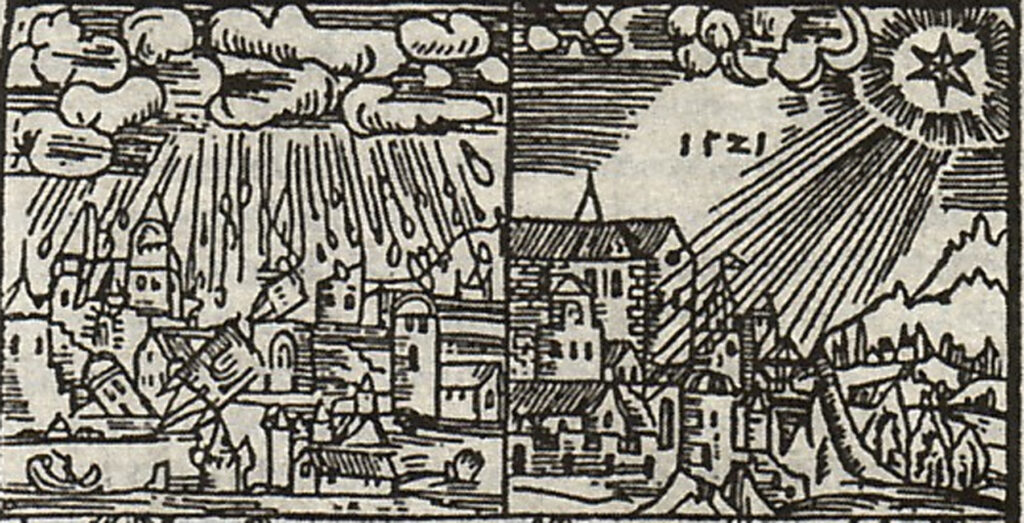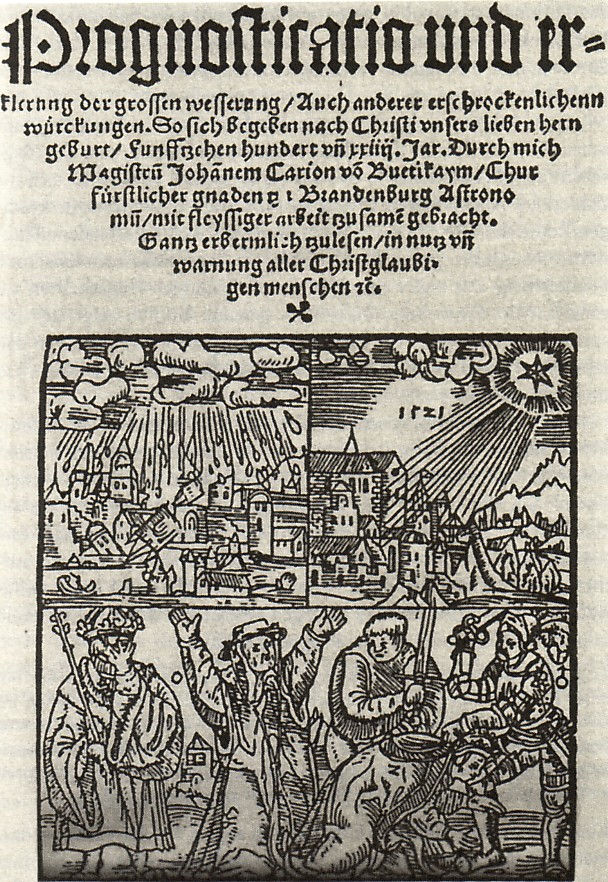Today marks the 500th anniversary of when 20,000 people fled the centre of London to avoid a massive tidal wave that was about to devastate the city.
But the flood never arrived.
So why did Londoners abandon their homes and workplaces with such a conviction that destruction was about to happen? Well, in the 1520s, astrologers had been increasingly predicting that a mighty flood would rush up the Thames and destroy the city.
And they put an exact date on when this calamity would occur — 1st February 1524.
It was claimed that “the waters of the Thames would swell to such a height as to overflow the whole city of London, and wash away ten thousand houses,”
The date was no idle whim, for it marked a Grand Conjunction in astrological circles. The previous Grand Conjunction, of 1484 heralded the Reformation, so it seemed likely that the next one would be equally deadly to society. By their calculations, on 1st February 1524, all seven major planets would be in conjunction, and that would cause massive tides that would inundate London.
Thus warned, an estimated 20,000 people fled the city on the days before the flood was expected and made preparations. Many of the richer sort took up their abode on the heights of Highgate, Hampstead, and Blackheath; and some erected tents as far away as Waltham Abbey on the north and Croydon on the south of the Thames.
For example, oft-cited is the (disputed) story of William Bolton, prior of St Barts church, who erected a tower at his home in Cannonbury as a refuge from the predicted floods. On the eve of the deluge, he took residence in the tower with his servants and stocked it with provisions to last out the disaster.
The mass awareness of the impending doom was aided by the then recent development of the printing press, which made it easier to distribute seditious leaflets about the prediction, spreading the panic further than it might otherwise have reached.
The main protagonist was Luca Gaurico, an astrologer based at The Vatican — at a time when astrology was deemed to be perfectly sensible science — and his writings were interpreted as predicting a flood. Another astrologer, Johannes Carion published a pamphlet in 1521 showing the flood, followed by social breakdown as the peasants revolted and executed a clergyman.
Other pamphlets warned that the flood of 1524 was just the beginning of the end of days.
It’s estimated that more than 60 writers published predictions about the great deluge due to hit in 1524.
It wasn’t just London though, with most of Europe in an uproar, and reports of arks being built in Germany and Italy by the wealthy who were determined to ride out the storm.
Of course, as is often the case with the failure of an apocalypse to arrive, the prophets in this case blamed human error — their calculations were out by a hundred years.
Following the failure of the flood to occur, rival astrologers accused Gaurico of exaggerating his findings and censured him in the way that modern scientists are wont to do when faced with similar slights to their profession.
Weather wise, the year 1524 was actually dryer than usual.
Sources:
Storming The Ark, by Dr. Romeo Vitelli
Hull Daily Mail, 29th March 1930
Esoterica, Vol.9 (2007)
History of the Apocalypse, by Catalin Negru
Extraordinary Popular Delusions And The Madness Of Crowds, by Charles Mackey
The Environs of London: Kent, Essex, and Herts, by Daniel Lysons









Fascinating. A couple of points of detail.
As I understand it, the sensational warnings of Luca Gaurico were based on the ephemerides published by the German astronomers Johannes Stöffler and Jakob Pflaum in 1499, in an almanac which predicted a “grand conjunction” in Pisces in February 1524. More of a series of planetary conjunctions in a short period than one massive conjunction on one specific date, I think.
I’m not sure how much “the Reformation” (more of a process than an event) was really taking place in 1484 – the publication of Martin Luther’s 95 theses in 1517 is usually said to be the first significant event – but by 1524 it was certainly under way, given a boost by there widespread adoption of the printing press over the previous decades. For good or for ill, ideas could spread further and faster. Including millennial catastrophe hoaxes. Just as the internet does for us.
It was originally predicted in 1499 as a planetary alignment influenced event for the beginning of the astrological water sign of Pisces that would commence on 20 February 1524. Most reporting on this failed prognostication suggests that there are no known reports of exceptionally serious rain storm events at this time. There is, however, one such report that is overlooked that has serious ramifications for the probable coastal flooding that appears imminent in our own current future.
On February 24, 1524, while in the middle of his Atlantic crossing from France to America, Giovanni Verrazzano encountered what he termed, in his letter of report to his voyage sponsor, King Francis I of France, that: “we went through a storm as violent as ever sailing man encountered.” apparently lasting about 16 hours (The Voyages of Giovanni da Verrazzano by Lawrence C. Wroth). This letter was the inspiration for the British determination to begin colonization efforts in America, especially the 1602 attempt underwritten by Henry Wriothesley and led by Captain Gosnold, culminating in his constructing a trading fort on an islet on Cuttyhunk Island at virtually the same latitude (“situated on a parallel with Rome at 40 2/3 degrees”) as reported by Verrazzano during his 2 week stay in Narragansett Bay. Though Gosnold quickly abandoned this attempt at colonization, he soon followed it with another attempt at Jamestown. The French may have beaten the English to the claim and colonization of America had not the Verrazzano letter been translated to English and widely reported in print in the late 16th century. It may be possible that a French based America may not have been as destructive to the Environment as we arrogant Americans have been in leading the World towards a mass suicide, a virtual flood of bad intentions that has engulfed the planet, leading towards the vast coastal flooding. We are now just “Biden” our time in hopes that good sense “trumps” the authoritarian efforts of a megalomaniac led rise to an accelerated apocalypse.